#not meant as hate toward the original version of this post! we just have vastly different opinions lol
Explore tagged Tumblr posts
Text

credits to @manmadesunshine for remaking this meme. all of phil's characters serve cunt and im tired of pretending like they don't
#philza#c!philza#o!philza#osmp philza#qsmp philza#not meant as hate toward the original version of this post! we just have vastly different opinions lol#also shoutout philza nation. love u guys.#qphilza
1K notes
·
View notes
Text
Art Deep Dives #1 - The Value of Art ~
Hi everyone!
This is the start to another project I want to start on this account, a companion to my Art Advice tag, and each week or so I’ll be ‘deep diving’ into art history, arts & culture, society’s relationship to art, etc etc... (I basically want to make use of my history of art degree, and also because I genuinely love talking about this stuff... especially without the pressure of deadlines lol)
Side note: don’t worry about these being really ‘academic’ or ‘formal’, since neither of those things are in my vocabulary lol... this is a very casual, informal kind of ‘essay’ writing that I want to be accessible to everyone, regardless of how much you know about art!
This first one is a kind of follow up of my Art Advice post talking about references, and I’ll be talking about the ideas of how we ‘value’ art.
(this is about 1600 words long by the way...)
The Value of Art
It’s no secret that art is highly subjective. Particularly when it comes to the question of ‘what is the most important type of art?’. It changes from person to person, country to country, and era to era. How we define ‘great art’ now is vastly different to how we defined it several hundred years ago. I mean, just look at the kinds of art in galleries in the modern era (Tracey Emin’s bed comes to mind) versus that of the 18th century (with the likes of Joshua Reynolds, JMW Turner and Thomas Gainsborough). Really, it’s clear to see that what we see as ‘the most important type of art’ is forever changing...
Or... is it?
In order to really answer whether the kinds of art we value now versus that of the past has changed, we need to first establish what ‘valued art’ even means.
I think in today’s day and age, ‘value’ is often synonymous with ‘price’. So, a Banksy original chipped away from it’s original wall setting and having been sold at a Christies auction for £3.2million is, by this definition, what we as a society ‘value’ as art... Right? Or maybe ‘value’ is more to do with what kinds of works that are displayed in big galleries or public spaces? The Tate has an entire wing dedicated to the works of landscape/seascape painter JMW Turner, so surely that means that we today place a high ‘value’ on his work still? What about public sculpture? Architecture? Sculpture and architecture are often a lot more available for the general public, and even if most people wouldn’t be able to tell you who made the Statue of Liberty, they at least know about her and perhaps even enjoy to look at her? And surely the fame of buildings like the Eiffel Tower or the Taj Mahal mean that they, too, are ‘valued’ as pieces of art? And what of artworks from other countries and cultures? A Chinese man may find no ‘value’ in a painting by a so-called ‘Great Master’ of the Italian Renaissance, but instead will ‘value’ a piece of Imperial Ming Dynasty porcelain instead, does that mean his opinion is the ‘right’ one? Colonialism has played heavily into what arts are now called ‘valuable’ and what are not, so how do we quantify whether a work has ‘value’ without placing our own individual cultural bias on it?
Basically what I’m getting at is, what we value as art in this day and age is very complicated, in a big way because our society is complicated. But for the sake of arguments, and for my next few points, I will be defining an art’s ‘value’ predominantly by whether it has been featured in a big gallery... Which also means I’ll be focusing on painting and sculpture... And also focusing on the Western world of art, specifically Europe, which I want to clarify doesn’t mean I personally ‘value’ that art more, it’s just where I’m from and predominantly what I studied in my course...
Art historians often declare the Renaissance (around the 14th to 16th centuries) the ‘beginning’ of what we know as art today. But for this essay, I want to instead start a little before this, in the Early Medieval period. People often know of this era as ‘the dark ages’, in Europe at least, because it was after Rome had fallen and taken all their so-called ‘genius’ with them. A particular note for why for years we’ve seen this period as ‘regressive’ is through their art. A quick Google search of ‘Medieval baby’ will come up with a plethora of results for a wide range of paintings depicting babies (usually the baby Christ) as scaled down versions of adults, complete with receding hairlines and strangely buff arms and chests.

Now, is this because medieval babies actually looked like this? I think this is... highly unlikely... I know most things happened earlier in that era than nowadays (girls getting married and pregnant at age 14, for example), but I think it’s a bit of a stretch to think their babies had six packs... No, instead it’s more likely that rather than being direct representations of babies, these were purely symbolic. And particularly given how they often were of Christ, art historians often say that the weird adult-baby hybrids are to represent Christ’s divinity.
Now... What’s all this got to do with art and value? Well, the thing about early medieval art is that the value was almost entirely placed upon the symbology and meaning of a piece. Later in the medieval period, paintings began to become more ‘realistic’ to some extent, but it still for the most part stayed true to this idea of symbolism over representation.
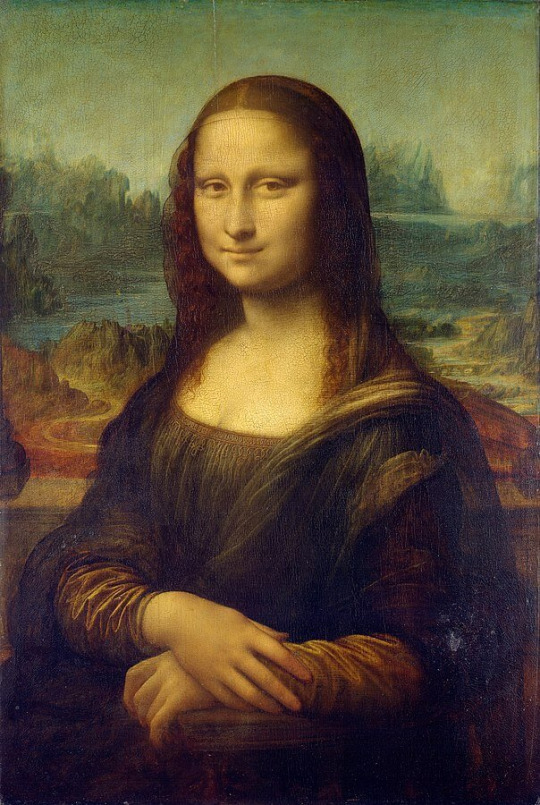
That is, until we get to the Renaissance and all of that gets thrown out of the window because artists want to be able to paint babies that actually look like babies, thank you very much! And with the likes of Leonardo da Vinci championing for art to become a science, surely this means that the kinds of art that was valued in this era were highly accurate portraits or landscapes... Right?
Short answer? No.
Long answer? Well, portraits and landscapes had their place in the hierarchies of art. Portraits were often commissioned by wealthy patrons, and were basically ways of the artist showing off how good their portrait skills are. And landscapes were less important, more seen as ‘nice backgrounds’ than anything else. But the art that was highly valued by most wealthy patrons and art connoisseurs of the time was... (imagine a drum roll here please)
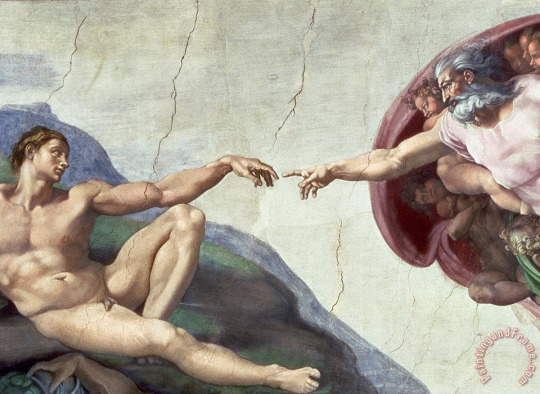
History painting! These are basically big biblical or mythological scenes, often with a lot of figures doing a variety of things (think Michelangelo’s Sistine Chapel), often with some pretty landscape as the backdrop, and often featuring a couple of portraits in the mix (including one of the patron who commissioned it, probably being blessed by the Virgin Mary, and a cheeky one of the artist peeking out from behind a bush or something...). From the Renaissance era up until basically the mid 19th century, History paintings were seen as the most important works of art to be featured in galleries.
And really, things only really began to change when we reached the end of the 19th century, with the development of photography.

Photography, and film, both lead to a massive shift in not only the kinds of art that are produced in the 20th century, but also the kinds of art that are valued. For so long art had been the main form of representation of society, and the advent of photographs meant that art had almost lost that ‘purpose’. Not to mention the leading towards a more secular society which no longer had a need for symbolic or spiritual artworks.
So, the only place art could really go was to become a form of expression instead. The likes of artists like Picasso and Braque pioneering cubism, being about new ways of representing the world. The Surrealists delving into ideas of the subconscious. Pop-Artists like Warhol looking into media and consumerist society, and the list goes on...
Which brings us onto my most hated period in the history of art: Conceptual art.
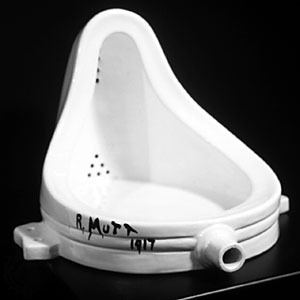
I’m not going to go big into this period, which is still around today (unfortunately), but all you need to know is this twat Marcel Duchamp flipped a urinal (which he didn’t even make himself) upside down and called it a ‘fountain’ and shoved it into a gallery and thus art that has no value beyond it being ‘concept based’ was born. And yes, yes I hate it a lot (I’m not even trying to be objective about this, I hate conceptual art with a burning passion... some guy put some sh*t in a box and put it in a gallery & called it art and I am SO mad about it lol...). And as much as I hate this period, what it does signify is how art began to be valued not through the craftsmanship of the work itself, but instead the ideas.
And this idea remains today. Damien Hirst has forged his entire art identity on creating works that are based entirely on some ‘meaning’ that could be forced onto it, rather than the aesthetic or material value. And as mentioned before, Tracey Emin’s infamous bed isn’t about the work and effort gone into the piece itself, but instead about what the artists intends for the piece to ‘mean’. So, the ‘value’ of the work is what it says, and not what it is, essentially.

(This is not to say that there are no artists who work today that get featured in galleries and are highly skilled at their craft. The one that springs to mind is Grayson Perry, who’s well known for his pottery and tapestries with some kind of social commentary bled into them.)
This ideology around art also bleeds into online spaces of art (which I see as distinctly separate from the world of art galleries and the Turner prize). I still see artists, and non-artists, talking about how much they enjoy work that is ‘original’, and oftentimes ridiculing and demoting ‘fanart’ as purely ‘derivative’ or ‘unoriginal’.
And all this brings us back to history paintings. Because their ‘value’ wasn’t just in the immense amount of skill that went into them. A large part of their ‘value’ was that artists and non-artists alike saw them as feats of the artist’s ‘genius’ or ‘imagination’ at play. And in the same way that Early Medieval art was valued for the symbology of the piece rather than the representation, history paintings had the benefit of including both elements. In essence, they were both meaningful AND beautiful.
In conclusion (just to remind you that this is technically an essay lol), a lot about art HAS definitely changed in the last few hundred years, particularly in what kinds of art is getting made now (and why we make art in the first place). However, what we as a collective society ‘value’ as art has remained surprisingly the same, often with a heavy preference for a work’s meaning and symbology, which can sometimes overshadow the craftsmanship of the work itself.
I still hate that godforsaken Duchamp toilet though...
(images used:
unknown medieval painting (I just liked that he had his hand down mary’s dress lool)
mona lisa by da vinky
detail of the creation of adam on the sistine chapel by michelangelo
a photograph by louis daguerre, often known as the father of photography
*clenches fist* ‘fountain’ by marcel duchamp
‘my bed’ by tracey emin )
I hope you enjoyed this informal essay about art, I will definitely be doing more of these in the future! If you have any thoughts on this, feel free to reply to this or message me, etc! I love having open and frank conversations about art!
#art history#art discussion#essay#history of art#art#long post#renaissance art#early medieval art#conceptual art#i over simplified a lot of this i know but i hope this is still interesting to read lol!#art deep dives#value of art#no sources or bibliography because we die like MEN#(also u want me to site things that i can't remember why or how i know them??? look just... trust me plz...)#(honestly this is more about sparking a discussion than anything lol)
9 notes
·
View notes
Text
Why ‘The Karate Kid Part II’ Deserves More Respect
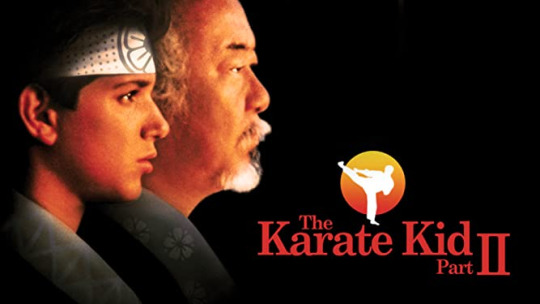
So guess what film I finished watching today? Of course, the Karate Kid franchise is considered iconic mainly for its first entry; Wax on Wax off, Skeleton fights, Sweep the Leg and the Crane Kick all cemented its legacy that allowed Cobra Kai to also be such a success. But imagine my shock when the approval rating on Rotten Tomatoes for Part II is 45% - 21% lower than the Jaden Smith ‘The Karate Kung Fu Kid’ version (and Part III is scored 15%, which is also super harsh but hard to debate outside of the magnificence of Terry Silver). Originally this was just gonna be a general post of how much I enjoyed retreading Part II, but upon seeing that score I had to give it my ‘Deserves More Respect’ posts.
It is an off-chance, but if you haven’t watched this film there will be spoilers within, I encourage you to watch it before reading, and maybe watch it again if you have so it’s fresh in the mind
Let’s start with a controversial point shall we? There are several parts where Part II is actually better than the original. Now I know! There’s a lot about the original which is iconic, but nostalgia does blind you to other shortcomings and while it’s easy to sell the first part because of its mystique, a sequel has the added pressure of rising above and developing on old and new themes set by the predecessor. The Premise In case you decided against refreshing your memory. Karate Kid Part II starts with a recap of Part I, a bit of content that was meant to be Part I’s final scene (in the script, not for filming) and then a timeskip. Ali with an i is gone - brutally dumping Daniel for some Football Player before Senior Prom and after crashing his car, Daniel’s mother is in Fresno for work and Miyagi has received a letter from his home Okinawa in news of his father’s fading health. The stage is set for Daniel and the audience to learn more about the iconic Mr. Miyagi and the life he left behind. Okay, so there is bad in this film Part II deserves respect, but it’s not perfect. It definitely gets messy near the end with Daniel’s antagonist Chozen, he mainly took beats from Johnny Lawrence in physically confronting Daniel when he could with a bunch of no-named goons and he fought pretty similarly to Johnny in catch counters and leg strikes. The opening recap did take a lot of time too, while the ending remained somewhat abrupt having just beaten up Chozen to embrace Kumiko (who had a delayed recovery after being punched once). While not bad, a fair amount of retreaded content felt like downgrades of the original; Chozen and Sato lacked the charisma of Johnny and Kreese, the crane kick was far more impressive than the drum technique and the Tournament setting was grander than the O-Bon festival. But, there are Iconic Moments in this film too Part I may have the Crane Kick and the Skeletons and the Training and Sweep the Leg. But people may forget that Part II had awesome moments too.
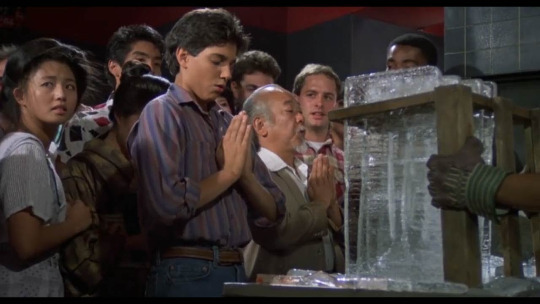
Like Daniel chopping through 6 Sheets of Ice! If that isn’t one hell of a power play I don’t know what is. It is a moment genuinely impressive in and outside of the 80s cheese universe of Karate Kid, and it gets referenced in Season 2 of Cobra Kai.
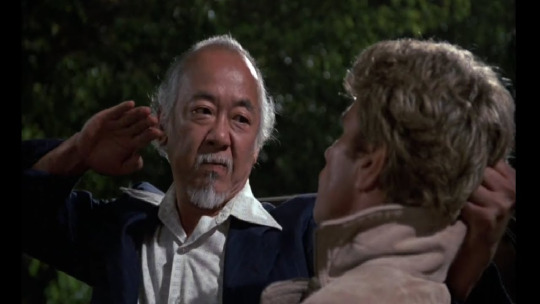
Also referenced in Season 2 is Miyagi vs Kreese. While this is the intended ending for Part I, it certainly acted better at the start of Part II, especially given that is foreshadows the situation Daniel finds himself in at the end of the movie. This moment is equally iconic as it completely encapsulates the character of both senseis - Kreese the confident brute brought to a sniveling mouse when size and power failed him and Miyagi the cool-headed and vastly more intelligent fighter still with the cheeky prankster lightness to him as he honks the scared shitless Kreese on the nose. Perfect.
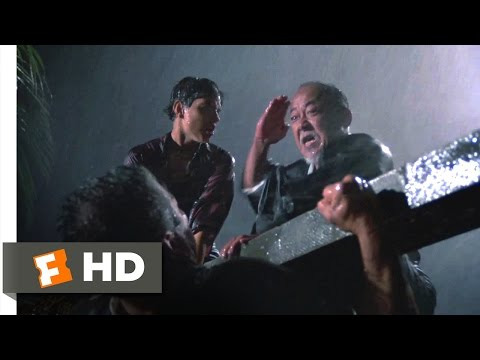
While I did want to cite the Tea Ceremony as well I think the more iconic moment for Part II had to be Miyagi chopping the log during the storm. The storm itself is a very well-done scene which unmasks several characters in the face of adversity. True tension, worry and stakes are sold as the village are in danger of the cruel whims of nature, an act which is all too real for Sato when the house he’s in collapses on him in the calm before his scheduled deathmatch with Miyagi. Not only is this again some great foreshadowing by the rule of three (Daniel asking if Miyagi can chop a log like Sato is doing with a banner and then Miyagi and Sato meeting and seeing Sato fail to chop a log) it proves a pivotal point where Sato turns from aggrieved antagonist to repenting ally. A great show of power and friendship as Miyagi metaphorically breaks the rift between their friendship that weighs Sato down. Okay, we hear you, but how is it better? I do have to preface that I do still love Part I, I have to because in pointing out where Part II is better I have to pick at Part I’s faults. While the ending is messy Part II definitely has much better pacing, until the skeletons scene Part I doesn’t really pick up because it has to set up, Part II while it does recap doesn’t need to worry about it. Giving Miyagi the main plot was definitely Part II’s strongest suit. Part I profited from Miyagi being the ‘mysterious old teacher’ but learning a lot more about his humanity and history was engrossing and it allowed positive development for Miyagi and Daniel, especially their bond as a surrogate father and son when Daniel personally goes out of his way to support Miyagi on a very personal matter. The main characters maintain their charm as well, still a lovely array of life lessons in Part II more than just finding balance, Miyagi teaches Daniel through words and action on taking time to breathe, to refocus when imbalanced, to forgive rather than to harbour hate, mercy, selflessness and humbleness
“never put passion before principle. Even if win, you lose.” - Mr. Miyagi
The scenes involving Miyagi and his father were some of the most deep and emotive of the series up until Cobra Kai, some still haven’t been topped such as Miyagi’s dad’s first words to his son or when Daniel talked about when his father died. And say what you will about Chozen, he does have a lot of Johnny vibes but a lot of the character we believed was Johnny due to nostalgia goggles was more fitting of Chozen’s manner. The story did a great job in making sure Chozen was always an asshole, at times Johnny did at least display honour and grace but Chozen was always sore about stuff and quick to claim dishonour even when he was in the wrong. Contrary to Johnny it’s more about his family than it is about a girl, which allowed a lot more freedom in the plot. Whether you felt Elizabeth Shue’s Ali with an i was prettier than Tamlyn Tomita’s Kumiko is up to personal preference, but the messy-haired Kumiko definitely had a slightly improved presence in Part II than Ali did, with actual focus on her own feelings outside of attraction to Daniel, her ambition to become a dancer directly linking to the O-Bon Festival - which in turn related to the Drum technique - as well as the delicately beautiful Tea Ceremony scene and actually contributing to the final fight (granted Ali wouldn’t be allowed to). Also Daniel didn’t try to eat her face which is a general improvement to the romantic subplot, extra applause has to go to Tomita here too because this was legitimately her first role - Shue had her second so that’s impressive too - and both women had good careers going forward. The increased stakes definitely worked in the favour of Part II as well, as sequel culture is forced to do, but by moving to Okinawa (actually filmed in Hawaii) we opened the door to better suit Miyagi’s world while keeping Daniel the fish out of water. I can’t speak too much for appropriation because there is still kinda some ‘white saviour’ undertones but I didn’t feel like Japan was treated negatively in this light, its culture of the O-Bon Festival and the Tea Ceremony was treated with the utmost respect and explained without pandering, the flute music had definitely stepped up its game for the soundtrack as did the imagery. Can also appreciate that Daniel does go for the Crane kick when fighting Chozen but is parried. Added hat tip has to go to costuming too. A lot of costumes would have to have distinct Kamon such as Sato’s twin fish and Miyagi’s bonsai on a lot of their clothing
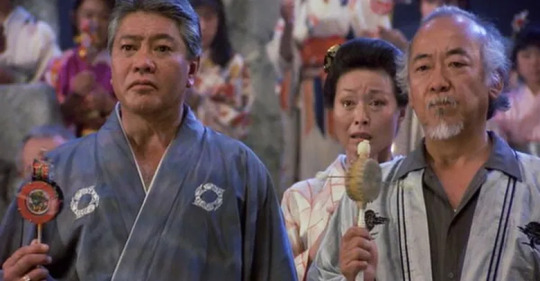
Between Sato and Miyagi the colours of their clothes often code their emotions towards each other, with Sato usually in grey and Miyagi in white or cream, when Sato and Miyagi prepare for death they are in black and when Sato wants forgiveness he moves to a lighter shade. While Part I also used black and white to differ Johnny and Daniel, Part II put Chozen and Daniel in the more Japanese-themed Red and Blue. While both men wear red, blue and whites at time, Chozen’s clothes almost devolve from the white he debuts in as his darker side comes out before flat out embracing yellow after his chance to prove his honour in the storm is refused (and he’s in white then), while Daniel often moves to Red or red tones even in his blue shirt. Kumiko also moves from white to blue, sometimes even purple, in set up to the final fight to have the primary colours stand out in the colourful crowd of the O-Bon festival, but even in the blue Kumiko had red to pair her connection with Daniel. Also her Yukata at the festival is just stunning, the Great Wave off Kanagawa print is a nice touch.
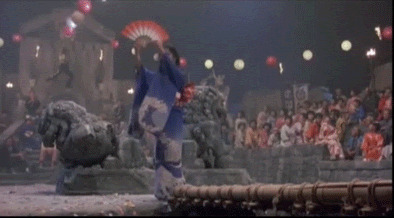
Anything else we should know? It might not be much else about the film itself I can tell you, but I do appreciate something I’m starting to call ‘The Rocky Connection’ when it comes to Karate Kid. Like Part I’s ‘You’re the Best (Around)’ was shortlisted for Rocky III, Part II’s song ‘Glory of Love’ was shortlisted for Rocky IV’s theme, losing to ‘Hearts on Fire’, Bill Conti also chose to score this film instead of Rocky IV. I like to pair this with Daniel’s Rocky-esque character, he has that same kind of swagger but a lot more naive and childlike. Martin Kove also gets a nod because those bleeding hands were legit, he had an accident on-set and the footage was kept for the final cut. Tamlyn Tomita wasn’t the only film debut for Part II, B.D. Wong of...well, several famous roles including but not limited to Shang in the animated Mulan, Dr. Wu in the Jurassic Park franchise, Hugo Strange in Gotham and many more, also had his debut here in a minor speaking role when he’s handing out flyers for the dance party to Kumiko and Daniel before the Ice Chopping Scene. So, why does it deserve respect A film that adds to a beloved character in a respectful fashion without having really any god awful moments does not deserve a 4.5/10 rating. It may not have as emphatic an ending or as great a villain but it has a captivating plot and a good pace, better stakes and much more emotionally driven and responsive scenes. A lot of effort and dedication went into this film to explore new dimensions of the main characters in a fashion which was enjoyable and at times heartwarming. And characters are given human moments, even Miyagi confesses himself not to be perfect and it keeps each character grounded. Even to this day parts of Part II are remembered fondly rather than the campness that Part III had outside of Terry Silver and his magnificent ponytail, the fondness also continues to reflect in Cobra Kai with homages and fan theories of Daniel going to Okinawa again and even re-encountering Chozen. Not to mention it grossed $113m on a $13m budget and got nominated for a Best Original Song Oscar (losing to Top Gun) Part II was a good and enjoyable film which deserves far more credit than to be rated this low, for that it deserves respect.
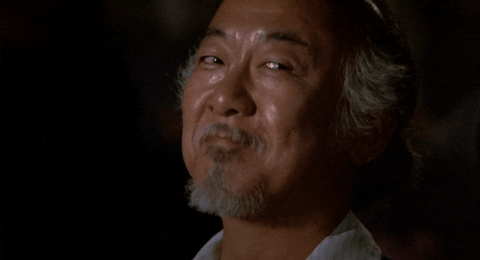
#karate kid#karate kid part ii#karate kid 2#daniel larusso#ralph macchio#mr miyagi#pat morita#chozen#yuji okumoto#kumiko#tamlyn tomita#sato#danny kamekona#john kreese#martin kove#johnny lawrence#billy zabka#yukie#nobu mccarthy#cobra kai
24 notes
·
View notes